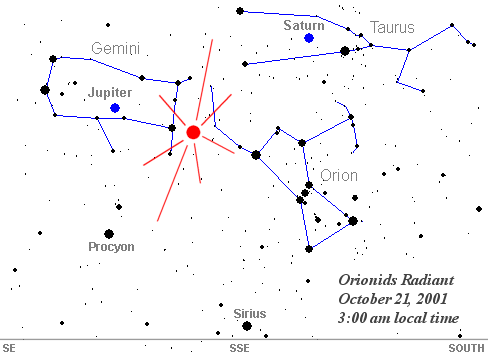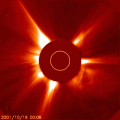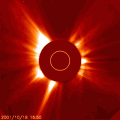ORIONIDS

|
18 meteors per hour at 0715 UT on Oct. 21 |

Useful links:
Space Weather News for October 21, 2001
Geomagnetic Activity Alert
The solar wind shock wave that buffeted Earth's magnetosphere today could be just the first of two heading for our planet. If so, the ongoing storm could intensify when the second arrives later today (Oct. 21) or tomorrow (Oct 22).
What's Up in Space -- October 20, 2001
This Weekend: Northern Lights and Meteors
 |
 |
On Friday, twisted magnetic fields above sunspot 9661 erupted powerfully -- not once, but twice -- at 0105 UT and again at 1640 UT. Both explosions unleashed category X1.6 solar flares and hurled lopsided coronal mass ejections (CMEs) toward Earth. The expanding clouds will likely strike Earth's magnetosphere on Oct. 21st and possibly ignite Northern Lights during this weekend's Orionid meteor shower.
NASA Science News for October 17, 2001
Halley's Comet Returns
The annual Orionid meteor shower peaks this weekend on October 21st. Sky
watchers will see as many as 20 fast shooting stars each hour -- each one
a tiny piece of Halley's Comet. NASA scientists plan to observe the
Orionids as a test of equipment they will use to record next month's
much-anticipated Leonid meteor storm.
... in Bits and Pieces
What's Up in Space -- 17 Oct 2001
METEOR WATCH
The annual Orionid meteor shower peaks this weekend on October 21st.
Sky watchers in either hemisphere who venture outdoors between 3 a.m.
and dawn on Sunday morning will see 10 to 20 meteors per hour streaming
from a point near the shoulder of the constellation Orion.
These meteors are debris shed by Halley's comet.
ORIONIDS
While everyone is talking about a possible outburst from the Leonids
this year don't forget the dependable Orionids. This major annual shower
produces rates averaging 10-20 meteors per hour at maximum. The best
activity usually occurs on morning of the 21st or 22nd of October but
can occur as early as the 18th or as late as the 25th.
The Orionids are the inbound particles from Halley's Comet. Although the comet is now long gone material has spread around its entire orbit so that meteor displays are visible every year at this time. During the week of maximum activity the radiant lies on the Orion-Gemini border northeast of the bright orange star Betelgeuse. Meteors from this shower are swift, faster than the Perseids of August. Although most Orionids are faint there are occasions when fireballs are produced. Most of these fireballs are brightly colored and leave behind persistent trains. Since most shower members are faint this shower is poorly observed from home in the suburbs. A good dark sky showing the winter Milky Way is needed to see this shower in all its glory. The Orionids become active after 11pm local daylight time and are best seen at 5am (LDT) when Orion stands upright on the meridian. Orionid meteors can be seen during the entire month of October and through the first week of November but in much lesser numbers away from the period of maximum activity.
Observers are urged to watch in one hour increments and to report the number of Orionids and the number of sporadics (random meteors) seen. It is also very helpful to estimate the limiting magnitude near the center of your field of view at least once an hour so that your personal sky conditions can be factored. A good web site for learning to estimate LM's is at http://www.seds.org/billa/lm
It is also important to note any hills, trees, or clouds that block your field of view while observing. It is also enjoyable to also try to record the magnitude of each meteor, color, speed 1(slow) to 5(fast), and any persistent train that is seen after the meteor has vanished.
Clear skies and be sure to let us know what you saw!
Bob Lunsford
International Meteor Organization
North American Coordinator
 Back to ASTRONET's home page
Back to ASTRONET's home page